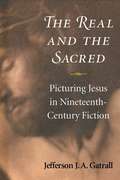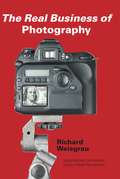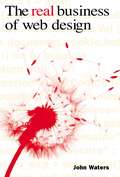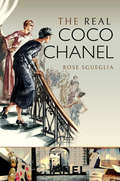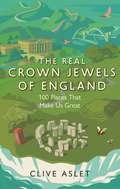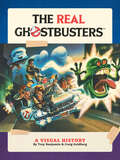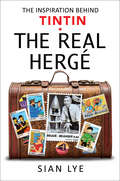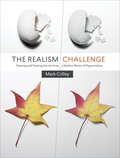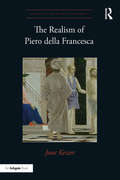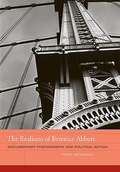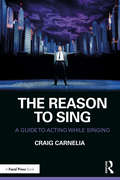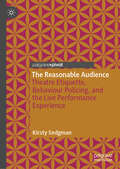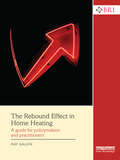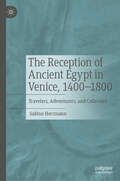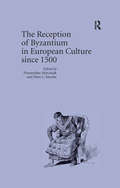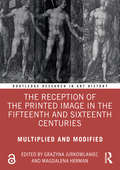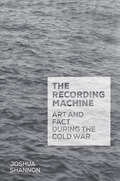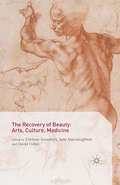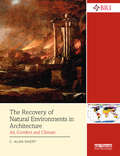- Table View
- List View
The Real And The Sacred: Picturing Jesus In Nineteenth-century Fiction
by Jefferson J. A. GatrallThe figure of Jesus appears as a character in dozens of nineteenth-century novels, including works by Balzac, Flaubert, Dickens, Dostoevsky, and others. The Real and the Sacred focuses in particular on two fiction genres: the Jesus redivivus tale and the Jesus novel. In the former, Christ makes surprise visits to earth, from rural Flanders (Balzac) and Muscovy (Turgenev) to the bustling streets of Paris (Flaubert), Seville (Dostoevsky), Berlin, and Boston. In the latter, the historical Jesus wanders through the picturesque towns and plains of first-century Galilee and Judea, attracting followers and enemies. In short, authors subjected Christ, the second person of the Christian trinity, to the realist norms of secular fiction. Thus the Jesus of nineteenth-century fiction was both situated within a specific time and place, whether ancient or modern, and positioned before the gaze of increasingly daring literary portraitists. The highest artistic challenge for authors was to paint, using mere words, a faithful picture of Jesus in all his humanity. The incongruity of a sacred figure inhabiting secular literary forms nevertheless tested the limits of modern realist style no less than the doctrine of Christ’s divinity. The international “quest of the historical Jesus” has been amply documented within the context of nineteenth-century biblical scholarship. Yet there has been no broad-based comparative study devoted to the depiction of Jesus in prose fiction over the same time period. The Real and the Sacred offers a comprehensive survey of this body of fiction, examining both the range of its Christ types and the varying formal means through which these types were represented. The nineteenth century—despite forecasts of God's death at the time—not only revived older Christ types but also witnessed the rise of new ones, including le Christ proletaire, the Mormon Christ, the Buddhist Christ, and the Tolstoyan Christ. Novelists played a crucial role in the invention and popularization of the historical Jesus in particular, one of modernity's major figures. These pioneering works of fiction, written by authors of diverse religious and national backgrounds, laid the formal groundwork for an enduring fascination with the historical Jesus in later fiction and film, from Mikhail Bulgakov's Master and Margarita to Mel Gibson's The Passion of the Christ. The book is enhanced by a gallery of illustrations of the historical Jesus as depicted by nineteenth-century artists.
The Real Business of Photography
by Richard WeisgrauThis honest, tell-all guide is written by one of the best-known players of the media photography business. Drawing from decades of experience as a working photographer and industry leader, the author defies popular business myths and trend-driven behavior by providing a fresh, common-sense approach to running a photography business. The essentials of running a photography business are covered-from setting a strategic vision to managing finances.
The Real Business of Web Design
by John WatersWritten by a veteran Web designer, The Real Business of Web Design goes beyond the usual philosophy of simply creating a better customer experience online. Instead, it provides an array of visual design practices and tested business principles for clarifying and simplifying the Web development process and making a Website more customer friendly. Filled with anecdotes from the author’s own experiences in the web design trenches, this guide shows readers how to use the Web in crucial ways to streamline communications, speed up transactions, boost profits, and much more. Anyone who wants to use the Internet as a valuable business tool should not be without this visionary resource! Author is a well-known and highly respected designer Combines visual design insights and proven business practices at a reasonable priceAllworth Press, an imprint of Skyhorse Publishing, publishes a broad range of books on the visual and performing arts, with emphasis on the business of art. Our titles cover subjects such as graphic design, theater, branding, fine art, photography, interior design, writing, acting, film, how to start careers, business and legal forms, business practices, and more. While we don't aspire to publish a New York Times bestseller or a national bestseller, we are deeply committed to quality books that help creative professionals succeed and thrive. We often publish in areas overlooked by other publishers and welcome the author whose expertise can help our audience of readers.
The Real Coco Chanel
by Rose SguegliaA biography of the French fashion icon that unveils the private life behind the public image. Coco Chanel lived her own life as a romantic heroine. Fueled by nineteenth-century literature, she built an image for herself which was partly myth and partly factual. She was the fashion designer everyone admired, the businesswoman whose fortune was impossible to track. She was also a performer, a lover of many high-profile intellectuals, and, as believed by many, a Nazi spy. This biography explores her life from her troubled and poverty-stricken past to the opening of her first hat shop to the creation of her iconic Little Black Dress and Chanel No. 5 perfume. It explores her passions and secrets; the drama behind the scenes of her empire; and the real woman behind the brand name and pop culture image.
The Real Coco Chanel
by Rose SguegliaA biography of the French fashion icon that unveils the private life behind the public image. Coco Chanel lived her own life as a romantic heroine. Fueled by nineteenth-century literature, she built an image for herself which was partly myth and partly factual. She was the fashion designer everyone admired, the businesswoman whose fortune was impossible to track. She was also a performer, a lover of many high-profile intellectuals, and, as believed by many, a Nazi spy. This biography explores her life from her troubled and poverty-stricken past to the opening of her first hat shop to the creation of her iconic Little Black Dress and Chanel No. 5 perfume. It explores her passions and secrets; the drama behind the scenes of her empire; and the real woman behind the brand name and pop culture image.
The Real Crown Jewels of England: 100 Places That Make Us Great
by Clive Aslet'Written with both charm and elegance, The Real Crown Jewels of England is a triumphant tribute to some of England's original treasures . . . lovingly captures the magic of the places that underpin our national identity and is a chance to rejoice in that heritage' Countryside On 15 April 2019, Paris's beloved Notre Dame was ablaze. It shocked the world - a revered landmark, a national symbol, a manifestation of French identity was here today, gone tomorrow. Life is fragile. So are the buildings, monuments and landscapes that move us. The question 'what would you save if your house was on fire?' is a familiar parlour game. But what would you save if England was on fire? What are the places that we most cherish, that express qualities that are especially English?In this delightful celebration of the real crown jewels of England, Clive Aslet takes us on a journey of 100 places that make our country great. From ancient oaks and Devon lanes to war memorials and the BBC, the white cliffs of Dover to views of Durham from the train, Aslet lovingly captures the magic of the places that underpin our national identity.The Real Crown Jewels of England is both an invitation to rejoice in our common heritage, and to discover the world of astonishing beauty that lies just beyond your doorstep.'Clive Aslet has been an extraordinarily informed and influential standard-bearer for the cause of the countryside and Britain's heritage for many years' Max Hastings
The Real Ghostbusters: A Visual History
by Troy Benjamin CRAIG GOLDBERGA full-color hardcover volume chronicling the history of The Real Ghostbusters with creator interviews, original animation scans, toy photography, and much more!After nearly forty years, the 1984 classic Ghostbusters endures. The original film introduced the world to Peter Venkman, Ray Stantz, Egon Spengler, Winston Zeddemore, Ectomobiles, Proton Packs, the Stay-Puft Marshmallow Man, and Slimer, just to name a few.A global-phenomenon, Ghostbusters soon made the trans-dimensional sidestep to animation with 1986&’s The Real Ghostbusters. The Saturday morning cartoon was an incredible success. For many kids, the animated series acted as their gateway into loving Ghostbusters long before they were age-appropriate to see the film. The series was acclaimed for its mature storytelling, fantastical animation, and a voice cast that became as synonymous with the characters as the live-action actors who originated them. A simultaneous toy launch from Kenner ectoplasmatically energized the property with some of the most memorable, most-beloved, weirdest, and best-selling toys in popular culture.The Real Ghostbusters: The Ultimate Visual History is the ultimate collector&’s dream. This franchise overview combines rare and never-before-seen visuals including conceptual artwork, storyboards, script excerpts, internal memos, packaging art, unseen prototypes, abandoned concepts, and brand-new stunning photography with new and exclusive interviews.
The Real Hergé: The Inspiration Behind Tintin
by Sian Lye“If you are looking to understand a bit more about the circumstances that inspired The Adventures of Tintin—this book will provide a good snapshot.” —The BookBuff ReviewHergé created only twenty-four Tintin books which have been translated into more than seventy languages and sold 230 million copies worldwide.The Real Hergé: The Inspiration Behind Tintin takes an in-depth look at the man behind the cultural phenomenon and the history that helped shape these books.As well as focusing on the controversies that engulfed Hergé, this biography will also look at his personal life, as well as the relationships and experiences that influenced him.“Tintin is more famous now than when Hergé was actually writing and illustrating his adventures. Sian Mye’s book is another in the excellent series about the real lives of our most famous authors, and is well worth a look. Brilliant!” —Books Monthly“It is certainly possible to enjoy the Tintin books without knowing Hergé. But they are more interesting after learning about this complex, sometimes frustrating, man. We can learn from him, even if we learn from his mistakes.” —Rose City Reader
The Real Hergé: The Inspiration Behind Tintin
by Sian Lye&“If you are looking to understand a bit more about the circumstances that inspired The Adventures of Tintin—this book will provide a good snapshot.&” —The BookBuff Review Hergé created only twenty-four Tintin books which have been translated into more than seventy languages and sold 230 million copies worldwide.The Real Hergé: The Inspiration Behind Tintin takes an in-depth look at the man behind the cultural phenomenon and the history that helped shape these books. As well as focusing on the controversies that engulfed Hergé, this biography will also look at his personal life, as well as the relationships and experiences that influenced him.&“Tintin is more famous now than when Hergé was actually writing and illustrating his adventures. Sian Mye&’s book is another in the excellent series about the real lives of our most famous authors, and is well worth a look. Brilliant!&” —Books Monthly&“It is certainly possible to enjoy the Tintin books without knowing Hergé. But they are more interesting after learning about this complex, sometimes frustrating, man. We can learn from him, even if we learn from his mistakes.&” —Rose City Reader
The Real James Dean: Intimate Memories from Those Who Knew Him Best
by Peter Winkler George StevensIn the decades following his death, many of those who knew James Dean best--actors, directors, friends, lovers (both men and women), photographers, and Hollywood columnists--shared stories of their first-person experiences with him in interviews and in the articles and autobiographies they wrote. Their recollections of Dean became lost in fragile back issues of movie magazines and newspapers and in out-of-print books that are extremely hard to find. Until now. The Real James Dean is the first book of its kind: a rich collection spanning six decades of writing in which many of the people whose lives were touched by Dean recall their indelible experiences with him in their own words. Here are the memorable personal accounts of Dean from his high school and college drama teachers; the girl he almost married; costars like Rock Hudson, Natalie Wood, Jim Backus, and Raymond Massey; directors Elia Kazan, Nicholas Ray, and George Stevens; entertainer Eartha Kitt; gossip queen Hedda Hopper; the passenger who accompanied Dean on his final, fatal road trip; and a host of his other friends and colleagues.
The Real Leonardo Da Vinci
by Rose SguegliaLeonardo Da Vinci was left-handed. That’s probably why he wrote backwards from right to left to avoid smudging ink on his hand as he made notes on his latest works and visionary discoveries. Words could only be read with the help of a mirror making it taxing for anyone but himself to quickly decode his handwriting. There are many theories exploring the reason why he kept using “mirror writing” in all his manuscripts. Some historians say that he was trying to make it more challenging for people to steal his ideas while others claim that it was a clever attempt to hide scientific findings from the intolerant Roman Catholic Church of the Renaissance. Whatever the logic behind this, the constant association with mirror writing and studies on the human body anatomy, made him one of the most enigmatic figures of his and then of our century. This biography investigates Leonardo and his different roles from anatomist to inventor, architect, painter, rumoured to be templar and scientific pioneer. Despite leaving several of his works incomplete, Leonardo managed to influence generations of artists and still today remains a highly regarded figure in both the artistic and scientific sector.
The Real Story of Lucille Ball
by Eleanor HarrisThe difficult early years…The truth about her and Desi…What’s behind I Love Lucy…First published in 1954, this is the full story of the actress who struggled to achieve stardom in the savagely competitive world of Hollywood and then went on to top place in television. And the story of the woman who won the harder battle of preserving the things she loved—marriage, home, and family—against the unceasing demands of success.
The Realism Challenge
by Mark CrilleyA captivating, step-by-step guide that teaches artists to draw and paint exact duplicates of common objects, rendered in the trompe l'oeil, hyperrealistic style of artist Mark Crilley's popular YouTube video series. Are You Up to the Challenge? With just watercolors, colored pencils, and white gouache, artist Mark Crilley takes you step-by-step through his process for producing stunning, hyperrealistic recreations of everyday items. Based on Crilley's mega-popular "Realism Challenge" YouTube videos, The Realism Challenge contains thirty lessons demonstrating how to render mirror-like duplicates in the trompe l'oeil tradition of everything from shells, leaves, and candy bars to your very own still life arrangements. Each lesson builds off the previous one, as you'll master essential artistic techniques like creating drop shadows, adding highlights, and building from light to dark. Learn the secrets of one of hyperrealism's biggest stars. Come take . . . The Realism Challenge!From the Trade Paperback edition.n master in order to conquer The Realism Challenge.
The Realism of Piero della Francesca: Life And Work (Visual Culture in Early Modernity)
by Joost KeizerThe fifteenth-century Italian artist Piero della Francesca painted a familiar world. Roads wind through hilly landscapes, run past farms, sheds, barns, and villages. This is the world in which Piero lived. At the same time, Piero’s paintings depict a world that is distant. The subjects of his pictures are often Christian and that means that their setting is the Holy Land, a place Piero had never visited. The Realism of Piero della Francesca studies this paradoxical aspect of Piero’s art. It tells the story of an artist who could think of the local churches, palaces, and landscapes in and around his hometown of Sansepolcro as miraculously built replicas of the monuments of Jerusalem. Piero’s application of perspective, to which he devoted a long treatise, was meant to convince his contemporaries that his paintings report on things that Piero actually observed. Piero’s methodical way of painting seems to have offered no room for his own fantasy. His art looks deliberately styleless. This book uncovers a world in which painting needed to validate itself by cultivating the illusion that it reported on things observed instead of things imagined by the artist. Piero’s painting claimed truth in a world of increasing uncertainties.
The Realisms of Berenice Abbott: Documentary Photography and Political Action
by Terri WeissmanThe Realisms of Berenice Abbott provides the first in-depth consideration of the work of photographer Berenice Abbott. Though best known for her 1930s documentary images of New York City, this book examines a broad range of Abbott's work--including portraits from the 1920s, little known and uncompleted projects from the 1930s, and experimental science photography from the 1950s. It argues that Abbott consistently relied on realism as the theoretical armature for her work, even as her understanding of that term changed over time and in relation to specific historical circumstances. But as Weissman demonstrates, Abbott's unflinching commitment to "realist" aesthetics led her to develop a critical theory of documentary that recognizes the complexity of representation without excluding or obscuring a connection between art and engagement in the political public sphere. In telling Abbott's story, The Realisms of Berenice Abbott reveals insights into the politics and social context of documentary production and presents a thoughtful analysis of why documentary remains a compelling artistic strategy today.
The Reality Shows
by Ann Pellegrini Karen Finley Kathleen Hanna"Ms. Finley hasn't lost the power to disturb."-Ben Brantley, The New York TimesNo other contemporary performing artist has captured the psychological complexity of this decade's political and social milestones as Karen Finley has in the past ten years. In her inimitable style, Finley has embodied some of the most troubling figures to cast a long shadow on the public imagination, and has envisioned a kind of catharsis within each drama: Liza Minnelli responds to the September 11 attacks; Terri Schaivo explains why Americans love a woman in a coma; Martha Stewart dumps George W. Bush during their tryst on the eve of the Republican National Convention; Silda Spitzer tells the former governor why "I'm sorry" just isn't enough; Jackie O cries, "Please stop looking at me!"The Reality Shows is a revelation of a decade by one of our greatest interpreters of popular and political culture.Karen Finley's raw and transgressive performances have long provoked controversy and debate. She has appeared and exhibited her visual art, performances, and plays internationally. The author of many books, including A Different Kind Of Intimacy, George & Martha, and Shock Treatment, she is a professor at the Tisch School of Art and Public Policy at NYU.Kathleen Hanna, activist and writer, was the lead singer of the punk band Bikini Kill before fronting the dance-punk band Le Tigre. She released a solo album under the name Julie Ruin.
The Reason to Sing: A Guide to Acting While Singing
by Craig CarneliaIn The Reason to Sing, renowned composer-lyricist and teacher Craig Carnelia provides musical actors with a step-by-step guide to making their singing performances more truthful, vivid, and full of life. Using a technique developed over decades of teaching the professional community of Broadway actors and students alike, The Reason to Sing utilizes detailed descriptions of sessions the author has had with his notable students and lays out a new and proven approach to help you build your skills, your confidence, and your career. This book is intended for musical theater acting students as well as working professionals and teachers of the craft.
The Reasonable Audience: Theatre Etiquette, Behaviour Policing, And The Live Performance Experience
by Kirsty SedgmanAudiences are not what they used to be. Munching crisps or snapping selfies, chatting loudly or charging phones onstage – bad behaviour in theatre is apparently on the rise. And lately some spectators have begun to fight back…The Reasonable Audience explores the recent trend of ‘theatre etiquette’: an audience-led crusade to bring ‘manners and respect’ back to the auditorium. This comes at a time when, around the world, arts institutions are working to balance the traditional pleasures of receptive quietness with the need to foster more inclusive experiences. Through investigating the rhetorics of morality underpinning both sides of the argument, this book examines how models of 'good' and 'bad' spectatorship are constructed and legitimised. Is theatre etiquette actually snobbish? Are audiences really more selfish? Who gets to decide what counts as ‘reasonable’ within public space?Using theatre etiquette to explore wider issues of social participation, cultural exclusion, and the politics of identity, Kirsty Sedgman asks what it means to police the behaviour of others.
The Rebound Effect in Home Heating: A guide for policymakers and practitioners (Building Research and Information)
by Ray GalvinThis is a definitive guide to the rebound effect in home heating – the increase in energy service use after a technological intervention aimed at reducing consumption. It sets out what the effect is, how it plays out in the home heating sector, what this implies for energy saving initiatives in this sector, and how it relates to rebound effects in other sectors. The book outlines how the concept of the rebound effect has been developed and the scope of research on it, both generally and particularly in the home heating sector. Within the context of energy and CO2 emissions policy, it summarises the empirical evidence, exploring its causes and the attempts that are being made to mitigate it. Various definitions of the rebound effect are considered, in particular the idea of the effect as an energy-efficiency ‘elasticity’. The book shows how this definition can be rigorously applied to thermal retrofits, and to national consumption data, to give logically consistent rebound effect results that can be coherently compared with those of other sectors, and allow policy makers to have more confidence in the predictions about potential energy savings.
The Reception of Ancient Egypt in Venice, 1400-1800: Travelers, Adventurers, and Collectors
by Sabine HerrmannThis book examines for the first time how ancient Egypt is reflected in early modern Venetian sources. As a center of the printing industry, Venice was an important hub for the accumulation and dissemination of direct information on the Near East and the Levant. Therefore, ancient Egypt played a significant role in the cultural memory of Venice due to the lagoon city’s religious and mercantile orientation towards the East. The book explores how the acquisition, selection, and interpretation of Egyptian objects took shape in Venice, and which actors were involved in the circulation of knowledge about ancient Egypt. Venice can be used as a lens through which to understand the reception of ancient Egypt in the early modern period. Meaningful and partly unpublished sources from primarily Italian archives highlight the visual imagination of ancient Egypt and its lexicographical codification. The author draws upon these sources to examine the Venetian image of ancient Egypt in the early modern period and the epistemic change that accompanied it.
The Reception of Byzantium in European Culture since 1500
by Przemyslaw Marciniak Dion C. SmytheStudies on the reception of the classical tradition are an indispensable part of classical studies. Understanding the importance of ancient civilization means also studying how it was used subsequently. This kind of approach is still relatively rare in the field of Byzantine Studies. This volume, which is the result of the range of interests in (mostly) non-English-speaking research communities, takes an important step to filling this gap by investigating the place and dimensions of ’Byzantium after Byzantium’. This collection of essays uses the idea of ’reception-theory’ and expands it to show how European societies after Byzantium have responded to both the reality, and the idea of Byzantine Civilisation. The authors discuss various forms of Byzantine influence in the post-Byzantine world from architecture to literature to music to the place of Byzantium in modern political debates (e.g. in Russia). The intentional focus of the present volume is on those aspects of Byzantine reception less well-known to English-reading audiences, which accounts for the inclusion of Bulgarian, Czech, Polish and Russian perspectives. As a result this book shows that although so-called 'Byzantinism' is a pan-European phenomenon, it is made manifest in local/national versions. The volume brings together specialists from various countries, mainly Byzantinists, whose works focus not only on Byzantine Studies (that is history, literature and culture of the Byzantine Empire), but also on the influence of Byzantine culture on the world after the Fall of Constantinople.
The Reception of the Printed Image in the Fifteenth and Sixteenth Centuries: Multiplied and Modified (Routledge Research in Art History)
by Grażyna JurkowlaniecThis book examines the early development of the graphic arts from the perspectives of material things, human actors and immaterial representations while broadening the geographic field of inquiry to Central Europe and the British Isles and considering the reception of the prints on other continents. The role of human actors proves particularly prominent, i.e. the circumstances that informed creators’, producers’, owners’ and beholders’ motivations and responses. Certainly, such a complex relationship between things, people and images is not an exclusive feature of the pre-modern period’s print cultures. However, the rise of printmaking challenged some established rules in the arts and visual realms and thus provides a fruitful point of departure for further study of the development of the various functions and responses to printed images in the sixteenth century. The book will be of interest to scholars working in art history, print history, book history and European studies. The introduction of this book is freely available as a downloadable Open Access PDF under a Creative Commons Attribution-Non Commercial-No Derivatives 4.0 license at https://www.taylorfrancis.com/chapters/oa-edit/10.4324/9781003029199-1/introduction-gra%C5%BCyna-jurkowlaniec-magdalena-herman?context=ubx&refId=b6a86646-c9f3-490d-8a06-2946acd75fda
The Recording Machine: Art and Fact during the Cold War
by Joshua ShannonA revealing look at the irrevocable change in art during the 1960s and its relationship to the modern culture of fact This refreshing and erudite book offers a new understanding of the transformation of photography and the visual arts around 1968. Author Joshua Shannon reveals an oddly stringent realism in the period, tracing artists’ rejection of essential truths in favor of surface appearances. Dubbing this tendency factualism, Shannon illuminates not only the Cold War’s preoccupation with data but also the rise of a pervasive culture of fact. Focusing on the United States and West Germany, where photodocumentary traditions intersected with 1960s politics, Shannon investigates a broad variety of art, ranging from conceptual photography and earthworks to photorealist painting and abstraction. He looks closely at art by Bernd and Hilla Becher, Robert Bechtle, Vija Celmins, Douglas Huebler, Gerhard Richter, and others. These artists explored fact’s role as a modern paradigm for talking, thinking, and knowing. Their art, Shannon concludes, helps to explain both the ambivalent anti-humanism of today’s avant-garde art and our own culture of fact.
The Recovery of Beauty: Arts, Culture, Medicine
by David Fuller Corinne SaundersAn interdisciplinary collection of essays exploring the complex and conflicted topic of beauty in cultural, arts and medicine, looking back through the long cultural history of beauty, and asking whether it is possible to 'recover beauty'.
The Recovery of Natural Environments in Architecture: Air, Comfort and Climate (Building Research and Information)
by C. Alan ShortThe Recovery of Natural Environments in Architecture challenges the modern practice of sealing up and mechanically cooling public scaled buildings in whichever climate and environment they are located. This book unravels the extremely complex history of understanding and perception of air, bad air, miasmas, airborne pathogens, beneficial thermal conditions, ideal climates and climate determinism. It uncovers inventive and entirely viable attempts to design large buildings, hospitals, theatres and academic buildings through the 19th and early 20th centuries, which use the configuration of the building itself and a shrewd understanding of the natural physics of airflow and fluid dynamics to make good, comfortable interior spaces. In exhuming these ideas and reinforcing them with contemporary scientific insight, the book proposes a recovery of the lost art and science of making naturally conditioned buildings.
